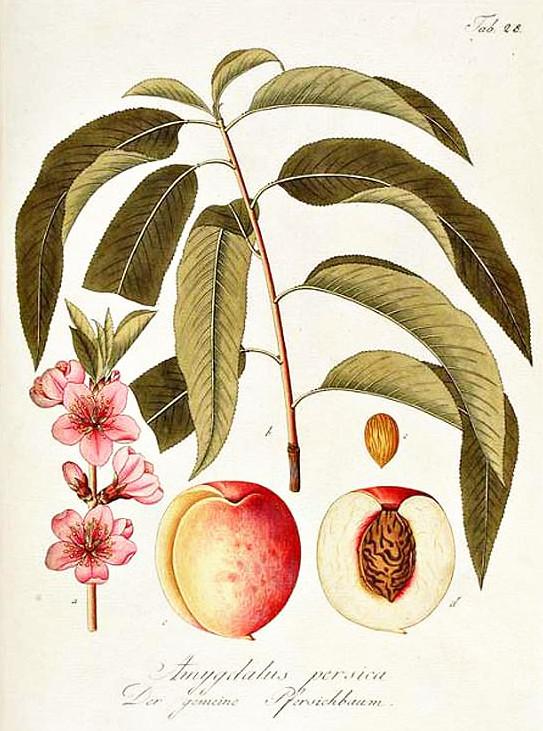Dies ist eine alte Version des Dokuments!
Prunus persica (L.) Batsch - syn.Amygdalus persica L. - Rosaceae
peach, Pfirsich, Pfirsichbaum
Small deciduous tree, up to 4(6)m high, widely cultivated, probably native to Northwest China; leaves glabrous, lanceolate to narrow-elliptic, serrulate; flowers solitary or paired, fragrant, pale pink; fruits globose, velvety or smooth, yellow to red, edible, juicy, also called peach.
Prunus persica (L.) Batsch var. persica = peach, Pfirsich
Prunus persica (L.) Batsch forma compressa (syn.Prunus persica var. platycarpa) = flat peach, Plattpfirsich
Prunus persica (L.) Batsch var. nucipersica (syn. Prunus persica var. nectarina) = nectarine, Nektarine
„Peaches (Prunus persica L., Batsch; cv. Glohaven) and nectarines (P. persica L., Batsch, var. nucipersica; cv. Maria Laura) were picked weekly from 57 days after full bloom (DAFB) to complete ripening on the tree in order to study the changes in volatile composition during fruit growth and ripening. Volatile substances were sampled from sliced pulp by dynamic headspace and analyzed by capillary Gas Chromatography (cGC) and gas chromatography/mass spectrometry. Volatile composition varied greatly, both quantitatively and qualitatively over time and between cultivars. Aldehydes, alcohols and esters showed a decreasing trend during fruit growth, with the exception of acetoin and (Z)-3-hexenol which reached the highest amounts in mature fruits. Glohaven peaches produced great amounts of lactones, mainly γ- and δ-decalactone, and γ- and δ-dodecalactone. Maria Laura nectarines produced less volatiles but more of esters and terpenoids (linalool and terpinolene) than peaches. As a consequence, nectarine aroma was more floral and fruity.“
[Volatile compound production during growth and ripening of peaches and nectarines., Visai, C., Vanoli, M., Scientia Horticulturae, Vol.70(1), 1997, 15-24]
„Application of aroma extract dilution analysis (AEDA) on a flavor extract isolated from a freshly prepared, enzyme-inactivated peach juice using solvent extraction and high-vacuum distillation (extract I) revealed 24 odor-active regions in the gas chromatogram. Flavor dilution (FD) factors ranged from 4 to 512. The highest FD factors were determined for β-damascenone (cooked-apple-like) and γ-decalactone (peach-like). Cooking of peaches for 2 h in an apparatus equipped for simultaneous steam distillation/extraction (extract II) yielded an overall more intense aroma extract (extract II). By AEDA, 30 odorants were detected in the FD-factor region of 4−16384 and were subsequently identified. The results revealed that in extract II, besides the two above-mentioned aroma compounds, both had FD factors of 16 384; δ-decalactone, γ-dodecalactone additionally, and 6-dodeceno-γ-lactone contributed with very high FD factors (FD 8192) to the overall aroma. In general, the thermal treatment led to the formation of 15 new odorants which were not detected in I. Furthermore, the lactones and β-damascenone were significantly increased in II, thereby indicating their generation from precursors in the fresh juice.“
[Differences in key odorants of handmade juice of yellow-flesh peaches (Prunus persica L.) induced by the workup procedure., Derail, C., Hofmann, T., Schieberle, P., Journal of agricultural and food chemistry, Vol.47(11), 1999, 4742-4745]
HS-SPME/GC-MS of tree-ripe ‘Fairtime’ peach flesh showed (Z)-2-hexen-1-yl acetate as main component (40%), with (Z)-4-hexen-1-yl acetate (29%) and hexyl acetate (28%).
[Changes in quality parameters and aroma volatiles compounds in ‘Fairtime’peach during fruit development and ripening., Agozzino, P., Avellone, G., Filizzola, F., Farina, V., Lo Bianco, R., Ital J Food Sci, Vol.19, 2007, 3-13]
„The quantitative distribution of volatile compounds in the skin, top mesocarp, middle mesocarp, bottom mesocarp, inner mesocarp, and outer mesocarp of a white-fleshed peach (cv. Maura) was investigated. Volatile compounds were extracted by liquid–liquid microextraction (LLME) and analyzed by GC–FID and GC–MS. The results showed that the levels of volatiles in skin were significantly higher than those observed in the other parts of the fruit, whereas top and bottom mesocarp were mainly discriminated by opposite concentrations in unsaturated lactones and C6-compounds. Distribution of lactones was also found to be different in skin and pulp according to their carbon chain length. Finally, the highest concentrations of benzaldehyde were found to be mainly located close to the stone suggesting that in peach this compound could be derived from enzymatic hydrolysis of amygdalin.“
[Distribution of the volatile compounds in the different parts of a white-fleshed peach (Prunus persica L. Batsch)., Aubert, C., Milhet, C., Food Chemistry, Vol.102(1), 2007, 375-384]

Prunus persica (L.) Batsch [as Amygdalus persica L.]
Schultz, F.J., Abbildung der in- und ausländischen Bäume, Stauden und Sträuche, welche in Oestreich fortkommen, vol. 1: t. 28 (1839)
http://plantgenera.org/species.php?id_species=1266152
